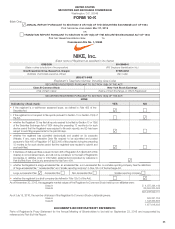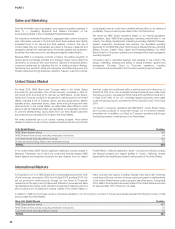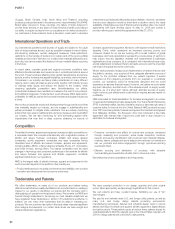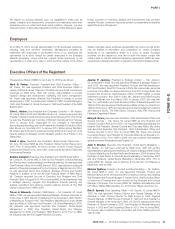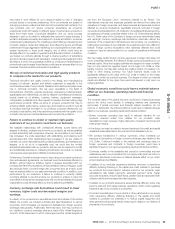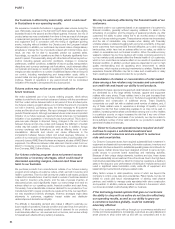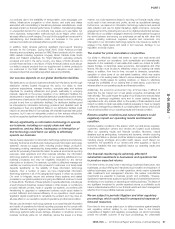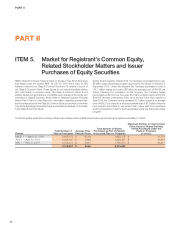Nike 2016 Annual Report Download - page 11
Download and view the complete annual report
Please find page 11 of the 2016 Nike annual report below. You can navigate through the pages in the report by either clicking on the pages listed below, or by using the keyword search tool below to find specific information within the annual report.PART I
Our business is affected by seasonality, which could result
in fluctuations in our operating results.
We experience moderate fluctuations in aggregate sales volume during the
year. Historically, revenues in the first and fourth fiscal quarters have slightly
exceeded those in the second and third fiscal quarters. However, the mix of
product sales may vary considerably from time to time as a result of changes
in seasonal and geographic demand for particular types of footwear, apparel
and equipment and in connection with the timing of significant sporting
events, including without limitation the Olympics and the European football
championship. In addition, our customers may cancel orders, change delivery
schedules or change the mix of products ordered with minimal notice. As a
result, we may not be able to accurately predict our quarterly sales.
Accordingly, our results of operations are likely to fluctuate significantly from
period to period. This seasonality, along with other factors that are beyond our
control, including general economic conditions, changes in consumer
preferences, weather conditions, availability of import quotas, transportation
disruptions and currency exchange rate fluctuations, could adversely affect
our business and cause our results of operations to fluctuate. Our operating
margins are also sensitive to a number of additional factors that are beyond
our control, including manufacturing and transportation costs, shifts in
product sales mix and geographic sales trends, all of which we expect to
continue. Results of operations in any period should not be considered
indicative of the results to be expected for any future period.
Futures orders may not be an accurate indication of our
future revenues.
We make substantial use of our futures ordering program, which allows
retailers to order five to six months in advance of delivery with the commitment
that their orders will be delivered within a set period of time at a fixed price.
Our futures ordering program allows us to minimize the amount of products
we hold in inventory, purchasing costs, the time necessary to fill customer
orders and the risk of non-delivery. We report changes in futures orders in our
periodic financial reports. Although we believe futures orders are an important
indicator of our future revenues, reported futures orders are not necessarily
indicative of our expectation of revenues for any future period. This is due to
year-over-year changes in shipment timing, changes in the mix of orders
between futures and at-once orders and because the fulfillment of certain
orders may fall outside of the schedule noted above. In addition, foreign
currency exchange rate fluctuations, as well as differing levels of order
cancellations, discounts and returns can cause differences in the
comparisons between futures orders and actual revenues. Moreover, a
portion of our revenue is not derived from futures orders, including sales of at-
once and closeout NIKE Brand footwear and apparel, all sales of NIKE Brand
equipment, the difference between retail sales and internal orders from our
Direct to Consumer in-line stores and e-commerce operations, and sales
from Converse, NIKE Golf and Hurley.
Our futures ordering program does not prevent excess
inventories or inventory shortages, which could result in
decreased operating margins, reduced cash flows and
harm to our business.
We purchase products from manufacturers outside of our futures ordering
program and in advance of customer orders, which we hold in inventory and
resell to customers. There is a risk we may be unable to sell excess products
ordered from manufacturers. Inventory levels in excess of customer demand
may result in inventory write-downs, and the sale of excess inventory at
discounted prices could significantly impair our brand image and have an
adverse effect on our operating results, financial condition and cash flows.
Conversely, if we underestimate consumer demand for our products or if our
manufacturers fail to supply products we require at the time we need them,
we may experience inventory shortages. Inventory shortages might delay
shipments to customers, negatively impact retailer and distributor
relationships and diminish brand loyalty.
The difficulty in forecasting demand also makes it difficult to estimate our
future results of operations, financial condition and cash flows from period to
period. A failure to accurately predict the level of demand for our products
could adversely affect our net revenues and net income, and we are unlikely
to forecast such effects with any certainty in advance.
We may be adversely affected by the financial health of our
customers.
We extend credit to our customers based on an assessment of a customer’s
financial condition, generally without requiring collateral. To assist in the
scheduling of production and the shipping of seasonal products, we offer
customers the ability to place orders five to six months ahead of delivery
under our futures ordering program. These advance orders may be canceled,
and the risk of cancellation may increase when dealing with financially
unstable retailers or retailers struggling with economic uncertainty. In the past,
some customers have experienced financial difficulties up to and including
bankruptcies, which have had an adverse effect on our sales, our ability to
collect on receivables and our financial condition. When the retail economy
weakens, retailers may be more cautious with orders. A slowing economy in
our key markets could adversely affect the financial health of our customers,
which in turn could have an adverse effect on our results of operations and
financial condition. In addition, product sales are dependent in part on high
quality merchandising and an appealing store environment to attract
consumers, which requires continuing investments by retailers. Retailers that
experience financial difficulties may fail to make such investments or delay
them, resulting in lower sales and orders for our products.
Consolidation of retailers or concentration of retail market
share among a few retailers may increase and concentrate
our credit risk and impair our ability to sell products.
The athletic footwear, apparel and equipment retail markets in some countries
are dominated by a few large athletic footwear, apparel and equipment
retailers with many stores. These retailers have in the past increased their
market share and may continue to do so in the future by expanding through
acquisitions and construction of additional stores. These situations
concentrate our credit risk with a relatively small number of retailers, and, if
any of these retailers were to experience a shortage of liquidity, it would
increase the risk that their outstanding payables to us may not be paid. In
addition, increasing market share concentration among one or a few retailers
in a particular country or region increases the risk that if any one of them
substantially reduces their purchases of our products, we may be unable to
find a sufficient number of other retail outlets for our products to sustain the
same level of sales and revenues.
Our Direct to Consumer operations have required and will
continue to require a substantial investment and
commitment of resources and are subject to numerous
risks and uncertainties.
Our Direct to Consumer stores have required substantial fixed investment in
equipment and leasehold improvements, information systems, inventory and
personnel. We have entered into substantial operating lease commitments for
retail space. Certain stores have been designed and built to serve as high-
profile venues to promote brand awareness and marketing activities.
Because of their unique design elements, locations and size, these stores
require substantially more investment than other stores. Due to the high fixed-
cost structure associated with our Direct to Consumer operations, a decline in
sales or the closure or poor performance of individual or multiple stores could
result in significant lease termination costs, write-offs of equipment and
leasehold improvements and employee-related costs.
Many factors unique to retail operations, some of which are beyond the
Company’s control, pose risks and uncertainties. Risks include, but are not
limited to: credit card fraud; mismanagement of existing retail channel
partners; and inability to manage costs associated with store construction
and operation. In addition, extreme weather conditions in the areas in which
our stores are located could adversely affect our business.
If the technology-based systems that give our customers
the ability to shop with us online do not function effectively,
our operating results, as well as our ability to grow our
e-commerce business globally, could be materially
adversely affected.
Many of our customers shop with us through our e-commerce website and
mobile commerce applications. Increasingly, customers are using tablets and
smart phones to shop online with us and with our competitors and to do
64


